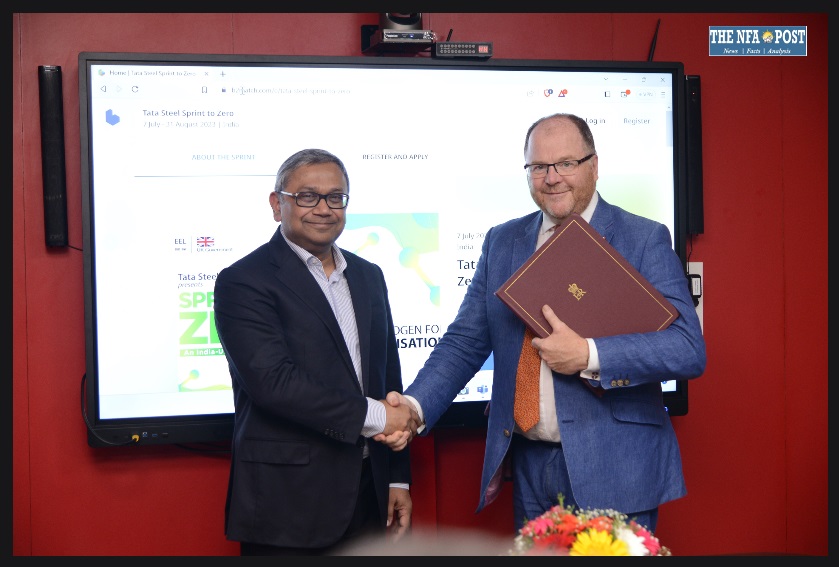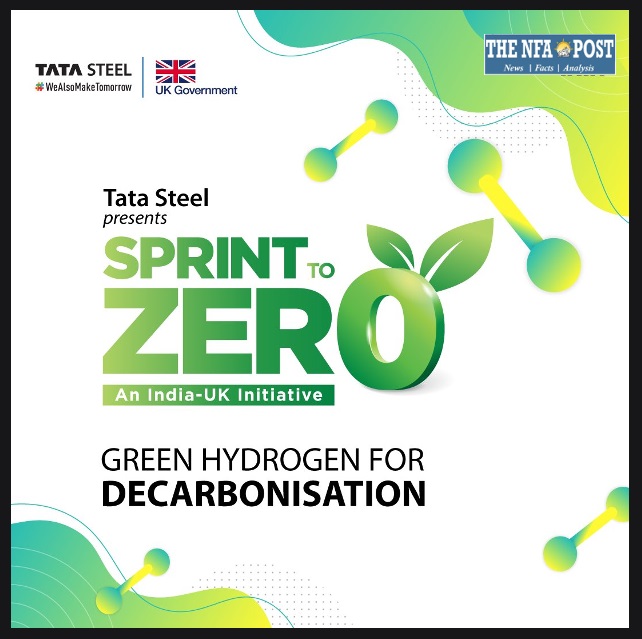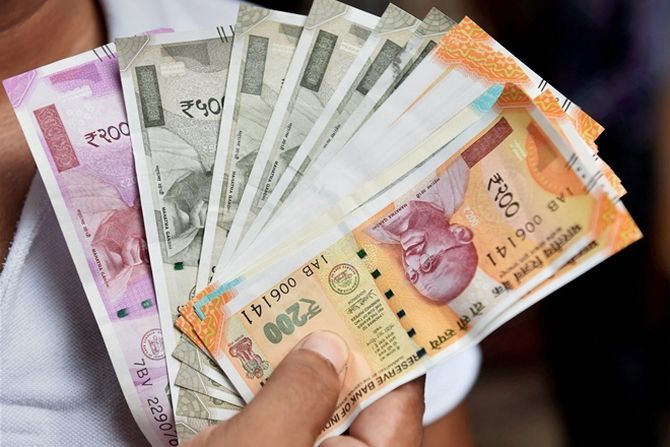~ Launch of ‘Tata Steel – Sprint to Zero’ 2023 challenge for greening of industrial sector with focus on steel through cost effective hydrogen ~
~ Initiative in line with India-UK agreement to work on climate change ~
~ Two winning projects to be funded up to £80,000 by Tata Steel ~
~ The steel giant will offer experiential engagement to winners including a priority access to its integrated steel plant ~
Bengaluru, NFAPost: As part of its ongoing efforts to decarbonise the steel sector, Tata Steel announces ‘Tata Steel – Sprint to Zero’ 2023 Challenge, an initiative to fund innovative research and development projects in low carbon hydrogen that offers tech-led or tech-enabled solutions to address green hydrogen technologies for the industrial sector’s sustainable future.
The announcement, part of the UK-India Hydrogen Partnerships, was jointly made by UK Minister of State for Science, Innovation and Technology George Freeman and Tata Steel Vice President (Technology and R&D) Debashish Bhattacharjee at IISc Bangalore.
The UK-India Hydrogen Partnerships builds on the UK-India Hydrogen Hub announced by the UK and Indian Prime Ministers in 2022. It will feature a range of private industry sponsored pilots to tackle 5 Grand Challenges – storage, transport, safety, production, and cost – faced by both countries.
Tata Steel is the first sponsor of the UK-India Hydrogen Partnerships sprint series, awarding £80,000 (~Rs 83 lakh) funding to two innovative projects in low carbon hydrogen. As part of the Challenge, the Company will also offer experiential engagement to selected entities including a priority access to its integrated steel plants.
The proposals bidding for the grant are expected to address two challenges: a) development and deployment of hydrogen technologies for greening the industrial sector and b) solutions for hydrogen storage/purification.
UK Minister of State for Science, Innovation and Technology George Freeman said across the world, steel is the construction backbone of so much of the global economy.
“Steelmaking is highly energy and carbon intensive, and cleaning up the steel industry is a key pillar of reducing global warming. Pairing up the UK’s expertise in low carbon manufacturing technology with the Indian steel industry, by working with progressive manufacturers like Tata Steel, we can unlock the innovations that will deliver the steel sector an environmentally sustainable future. For us all,” UK Minister of State for Science, Innovation and Technology George Freeman.

Tata Steel Vice President (Technology and R&D) Debashish Bhattacharjee said the priority of the steel sector today is to decarbonise and do it in a way that are both technologically and economically sustainable.
“While the current levels of carbon footprint from the steel sector is unsustainable, the available version of clean hydrogen faces numerous challenges like high operational cost and energy loss. We are committed to finding a solution to these challenges and have created a platform like ‘Tata Steel – Sprint to Zero 2023’ to ensure the best minds from academia and industry join hands in this effort,” said Tata Steel Vice President (Technology and R&D) Debashish Bhattacharjee.
Tata Steel Vice President (Technology and R&D) Debashish Bhattacharjee said the company is delighted to launch the Sprint initiative in partnership with the UK Government and look forward to a unique collation of UK and Indian innovation policymakers, R&D companies, start-ups, hubs and places, investors, research groups and Catapults.
The funding call is open for solutions from academia, startups and industries across India and the UK. The projects must be co-led by an Indian or a UK organisation with a maximum of three partners per project, where at least one organisation must be either from the UK or India, with a strong academic, research and development background.
The last date for submission of proposals is August 31, 2023, and winners will be announced by October 2023. The projects will commence from November 2023 and will last for 9-12 months.
‘Tata Steel – Sprint to Zero’ 2023 Challenge – Website: www.b2match.com/e/tata-steel-sprint-to-zero
Earlier this year, Tata Steel had executed the trial injection of hydrogen gas using 40% of the injection systems in ‘E’ Blast Furnace at its Jamshedpur Works. This was the first time in the world that such a large quantity of hydrogen gas was continuously injected in a blast furnace.
The grants are for projects lasting 9-12 months, starting around November 2023. Tata Steel may consider funding other bids of merit and further money if required by the chosen successful bidders to validate the technology proposition at their discretion. Tata Steel may also consider short term, early TRL, small budget proposals, however the proposed solution should be minimum at pilot stage.
Tata Steel is focused on identification of technologies related to electrolysers and fuel cell technologies, biomass, or enhancing battery storage capacity and improving manufacturing capabilities. This is most relevant to the organization’s or the sector’s needsRegister now to secure your spot and join us for an unforgettable experience!
Entrepreneurs and students have to choose any one of them.
Challenge Statement 1
We are looking for proposals that meet the primary criteria of addressing development and deployment of Hydrogen technologies in greening the industrial sector; the technology interventions that we are seeking should address the Greening the industrial sector.
Although critical for economic growth, the iron and steel sector are energy and resource intensive. Rapid growth of steel demand, using conventional Blast Furnace (BF) -Basic Oxygen Furnace (BOF) methods will have significant environmental consequences. There is a growing need to reduce CO2 emissions from iron & steel production with a goal to prevent the worst effects of climate change. Clean hydrogen offers a decarbonization solution to the Carbon intensive steel industry.
At present, although clean hydrogen is gaining traction across industries, it still faces numerous challenges like high operational costs and energy losses.
Thus to address the problem in a holistic way, Tata Steel is looking for a cleaner version which is “blue” hydrogen, for which the carbon emissions are captured and stored, or reused or else the cleanest one of all i.e., “green” hydrogen, which is generated by renewable energy sources without producing carbon emissions in the first place.
Generated through novel and cost-effective pathways;
Usage in iron and steelmaking processes;
Assist in reinforcing the commitments to United Nations Sustainable development Goals.
Challenge Statement 2
Solutions for Hydrogen Storage / Purification :
Fossil fuels are now the most important sources of energy. However, the world is moving towards alternate energy source as the fuel sources are fast running out and by-products of the combustion of such fuels are not environment friendly.
Problem :
If we focus on hydrogen as a green fuel, we will have to ensure the following:
Safe level of hydrogen permeation through the storage material
Minimisation of the degeneration of the container material involved through its possible chemical reactions with or in presence of the hydrogen fuel.
For the purification process, stability and performance of membranes under long-term operational conditions should be well established.
Looking Forward:
Permeabilty : Low hydrogen permeabilty of the material at various temperatures and pressures, as function of the composition of the composite material. This low permeabilty should be present at all usable physical conditions of the material used for storage.
Durability : The material should possess high toughness and good thermal stability. Also it should possess fatigue resistant properties to tensile and bending stress. There should be moderate tensile strength during winding and the material must be resistant to chemical corrosion. These properties to secure the durability should also remain functional in time
Purification : The measurement of gas separation performances using different mixed gases is desirable as size of different gas molecules has a significant impact on separation performance. The graphene-membranes should be fabricated and tested in the industrial module platforms, such as hollow fibres and wounded spirals, which are the most popular configurations for gas separation application.
In general, the material should be of low cost, light-weight with low density and should possess the same properties in all controlled testing environments
Eligibility
The funding call is open for solutions from academia, startups and industries across India and UK. Projects must be co – led by an Indian or a UK organisation; with a maximum of three partners per project, where at least one organisation must be either from the UK or India, with a strong academic, research and development background.
Grants will be awarded to a lead organisation which clearly needs to be identified in the proposal. Applicants must demonstrate collaboration with other organisations. Applicants will need to explain how their proposal will facilitate the development of partnerships between researchers, industry (including but not limited to start-ups, scale-ups and small & medium enterprises), and potentially NGOs, policymakers and practitioners in India and counterparts abroad.





